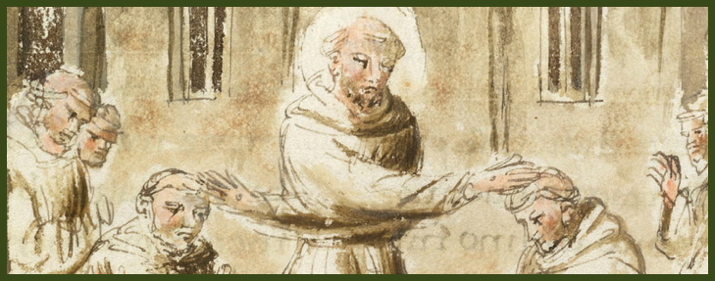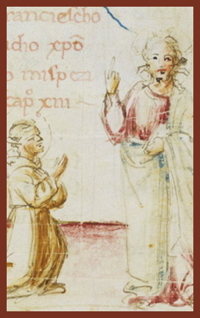One of the most important codices of the Italian miniature San Francesco d'Assisi —La vita e le opere Biblioteca Medicea Laurenzia Gaddi 112 format: 21.5 x 28.4 cm. 370 pp + commentary Limited edition of 999 copies Publisher's price: Eu 4,400 (please call for special OMI price) |
| | |
|
|
| One of the most important sources of the Italian miniature Ms. Gaddiano 112 perserved in the Biblioteca Medicea Laurenziana of Florence, contains an extraordinary recounting of Franciscan works, among them the Legend and Life of St. Francesco in two versions: “I Fioretti di San Francesco (fol. 1-43 & 137-142) and “Il Suo Testamento (fol. 164-166). The former extends beyond his testament the rules and considerations of the stigmata while the latter contains the treatise of the miracles of Tommaso da Celano which introduces the touching mystic journey, while the Life of fra Ginepro, Leone ed Egidio puts us in contact with some of the protagonists of the birth of the Francescan Order.. San Francesco d’Assisi – A revolutionary choice 1182 - approx. date of birth in Assisi 1206-1207 - His conversion and abandonment of the paternal house 1210 - Presentation of the First Rules 1217 - First chapter of the Franciscans 1219 - Trip to Egypt 1220 - Leaves the Superior Office 1223 - Approval of the Franciscan Rules 1224 - Received the stigmata in the "Monte della Verna" 1226 - Died in Assisi St. Francis of the Minor Brothers is one of the most venerated saints in the Christian world. Son of a rich merchant Pietro di Bernardone, his ambition was to become a Chevalier and to marry a noble woman. A religious crisis changed him and he decided to sell all his riches and distribute them among the poor. The church had always helped the poor but without abandoning their own privileges and wealth. St. Francis wanted to become poor and also that his brothers live in poverty; he forbad them to ask for money or alms. All of them should work with their own hands and receive in exchange some food. As a sign of humility the name of the order was “Frati Minori”, Minor Brothers. He was aware that his ideas were revolutionary and in confrontation of the church but prefered not to break his relation with it but to accelerate the changes with his example. History of the Manuscript and the Franciscan Spirit We know by a note that appears in the ms that it belonged to the Sisters of St. Onofrio, a Francescan Order. The colophon which appears on fol. 170 documents that the ms was finished on December 29, 1427. It went then to the Biblioteca Gaddi and in 1755 to the Biblioteca Magliabecchiana, finally resting in 1783 at the Biblioteca Laurenziana. The decoration of the ms which has 30 filigree initials of 39 narrated stories displays a technique in water color and ink which was not common at that time. In the Middle Ages it was a technique considered poor compared with the rich colors applied with paint brush. The design with ink and water color of the Trecento and Quattrocento is linked to a revival and renewed interest of the old classic culture and a desire to use a technique devoid of pomp and instead one having an utilitarian character which was a testimony to the unknown miniaturists of the Franciscan codex. The choice of this medium is consistent with the ideals of poverty predicated by St. Francesco that together with the historic and stylistic reasons connects the miniatures of this precious ms, attributed to the atelier of Bicci di Lorenzo (late gothic artist), in the Umbrian environs of the St. Onofrio Convent of the Terziarian Francescan Order of Foligno that initially possessed it. The codex is permeated in its literary stoic and figurative style of a spirit and stamp deeply Franciscan with an intense spiritual vision in order to make prevail the hypotheses that the writers and miniatures belonged to the order, as documented in the last words of the colophon “Oh, you that read, beg to God, that he forgives me and that I could serve Him”. On the other hand, during the Medieval Age, the great illuminated codici were in their majority the works of monastic centers and during the first decade of the 15th century this tradition was well alive specially in the important mendicant orders of the Franciscan and Dominicans. Ms Gaddiano 112 emphasizes with its text and iconography the fundamental values of the vivid and intense evangelical experience of St Francesco and his brothers, against the incipient mundanity of the Order. | |
Le sobrie iniziali di filigrana e le trenta storie miniate
La decorazione del codice si suddivide in lettere filigranate, cioè quelle degli incipit dei testi e dei capitoli, e in “storie” miniate. Le lettere, iniziali minuscole rosse e azzurre alternate, sono ornate con motivi di origine vegetale così stilizzati da essere realizzati col tratto della penna e con inchiostro rosso e azzurro alternati, ottenendo l’effetto di filigrana. Tutte le lettere filigranate hanno un campo, definito da linee parallele e orlato da una fitta serie di fogliette, i fondi delle lettere sono riempiti da palmette, da rametti trilobati e da fasce con nastri serpentinati. Le code sono formate da lunghi filamenti che terminano con una voluta, decorate con poche fogliette ovali formi, fiori a tre petali, occhielli, croci greche con dischetti terminali e qualche rosetta staccata dagli steli. Le trenta miniature sono tutte storie posizionate come vignette, o all’interno delle colonne oppure a fondo pagina, spesso dispongono della pagina intera insieme a poche righe di rubriche e sono eseguite a penna e inchiostro bruno e con acquarelli. Per le rubriche, che sono frasi di chiarimento e brevissime sintesi di contenuto, viene usato un inchiostro colorato rosso (ruber) che produce un effetto ornamentale.
distributed by:
La decorazione del codice si suddivide in lettere filigranate, cioè quelle degli incipit dei testi e dei capitoli, e in “storie” miniate. Le lettere, iniziali minuscole rosse e azzurre alternate, sono ornate con motivi di origine vegetale così stilizzati da essere realizzati col tratto della penna e con inchiostro rosso e azzurro alternati, ottenendo l’effetto di filigrana. Tutte le lettere filigranate hanno un campo, definito da linee parallele e orlato da una fitta serie di fogliette, i fondi delle lettere sono riempiti da palmette, da rametti trilobati e da fasce con nastri serpentinati. Le code sono formate da lunghi filamenti che terminano con una voluta, decorate con poche fogliette ovali formi, fiori a tre petali, occhielli, croci greche con dischetti terminali e qualche rosetta staccata dagli steli. Le trenta miniature sono tutte storie posizionate come vignette, o all’interno delle colonne oppure a fondo pagina, spesso dispongono della pagina intera insieme a poche righe di rubriche e sono eseguite a penna e inchiostro bruno e con acquarelli. Per le rubriche, che sono frasi di chiarimento e brevissime sintesi di contenuto, viene usato un inchiostro colorato rosso (ruber) che produce un effetto ornamentale.
distributed by:
OMI - Old Manuscripts & Incunabula PO Box 6019 FDR Station, New York NY 10150
tel/fax 212/ 758-1946 • http://www.omifacsimiles.com • immels@earthlink.net


